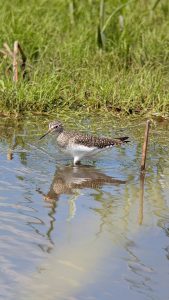Sunday 18 May
A wonderful start to our second week in Delaware Bay, we spent the evening at Dave’s for the annual BBQ he holds for the Shorebird Project. Before we could relax however, the morning was spent filling empty cartridges, finishing up a few last beach surveys for the period and of course cranking through the data entry and checking. Nigel also did a bit of a recce for some more walk-in trapping around Mispillion Harbour. With only partial success in our first week, we planned to make a big effort with walk-ins this week, there being lots of potential with the number of Dowitcher seen about the shores, and amongst the phragmites and marshes.
Monday 19 May

It was a rather dramatic day in the Harbour on Monday. Not one of the boat resighting trips produced any decent number of flag resightings at all. The culprit? Repeated fly-bys of juvenile Peregrine Falcon, attempting, and failing, to catch a meal, and in doing so flushing the shorebirds over and over again. Resighters saw the inexperienced falcons try their luck at large gulls, cormorants and a nesting Osprey!
A walk-in trap attempt on Lighthouse Road had more success. With a total of six shorebirds, the team caught one Ruddy Turnstone, one Short-billed Dowitcher, three Least Sandpiper and one Willet. An extra surprise was a Common Grackle! It’s not often we catch one of those! This week we are joined by Olga Bishop and her son Phillip Maleko. Phillip is studying Nordman Greenshank for his PhD – as well as the usual survey effort of all volunteers, they’ll be lending extra help to the walk-in trap teams with the use of Phillip’s bow net!
The highlight shorebird of the day was a pair of Solitary Sandpiper at North Bowers! “Nothing ironic about that is there?”, said Richard, who spotted the birds.
An amazing effort was put in by Nick today on data entry, and Ryan took on more than his fair share of tasks; shopping, sorting equipment and cooking. Fab effort both. During the evening meeting, we began making plans for a cannon-net catch in the Harbour. Nigel’s plan was clear: “We are going to get up before the Peregrines. Yes. That’s the hope”.
Tuesday 20 May
Unfortunately, despite the valiant effort, an early morning attempt to make a catch on Osprey was unsuccessful as the Peregrines were back at it again with the same youthful mischief. Yet again however, walk-in traps on Lighthouse Road were productive, and throughout the morning a total catch of 11 birds was made:10 Short-billed Dowitcher and one Willet.
The cannon-netting team made a quick turnaround and headed south along the Bay, looking for another catch option. It wasn’t long at all before an option was found on Fowler’s Beach and we made a catch. We got our Turnstone sample (there are very few Red Knot on this side of the Bay) – 78 birds in total comprising 75 Ruddy Turnstone and three Sanderling. Bracken Brown (who used to work on the Delaware Shorebird Project) from Hawk Mountain Sanctuary came to join us again this year with a crew of volunteers. This small catch provided the perfect opportunity for lots of training in shorebird handling and banding and the extra help meant it was a speedy process. Cathy, Lys, Nick and Michèle together surveyed Ted Harvey and Kits Hummock whilst the catch was in operation.
An afternoon of data entry was pleasantly followed by a hearty chilli cooked by Bracken.
Wednesday 21 May
All throughout the day strong onshore winds buffeted the Bay, making for tricky survey – but ideal data checking – conditions. It was not the Peregrine Falcon but the weather that created a deficit of shorebirds in the Harbour this time; the water surging endlessly up the beaches, over the Break Wall, into the pines on Osprey, and flooding the marshes. Flo surveyed, or, more accurately, swam Slaughter and Cedar Beach then somehow got to Osprey and managed to gather a handful of resightings, peering through the pines at the Ruddy Turnstone and Dowitcher desperately clinging to the scrap of beach revealed between the waves. A much higher number of birds were found at Pickering however – or “Pickle Beach”, as it was accidentally termed by Phillip, who returned with counts of 940 Dowitcher and 350 Turnstone.

Sadly, the Hawk Mountain crew left. It was great to have so much enthusiasm boosting the team and contributing so much to the data collection. We will hopefully see them again next year.
Nigel, Richard, Ryan, Rob Rob and Kat headed over to New Jersey for the day to catch up with the team catching and surveying on the other side. Ryan recalls details of their visit:
On the New Jersey (NJ) side of the bay, there are just as many researchers and wildlife biologists working to conserve the very same shorebirds we see in Delaware. Though the focus and approach can vary between states, the shorebirds using them do not recognise borders and so it is crucial to work collaboratively and share information as much as possible. This happens at multiple levels but starts with the teams working on the ground each season. In the morning, we met with David Mizrahi from NJ Audubon. David has been working on shorebirds for over 30 years, up and down the Atlantic coast from NJ to Brazil. We started flagging Short-billed Dowitchers this year and David and team are a few years ahead of us with that. We discussed future research opportunities and how we could collaborate to create a more joined up and valuable Dowitcher project. Later in the day, we met with the NJ team led by Larry Niles, from Wildlife Restoration Partnerships. Fellow Brit’ Humphrey Sitters, as much as part of the NJ team as Nigel is of Delaware’s, also welcomed us. Over lunch we talked about everything from how many shorebirds and Horseshoe Crabs were seen this year, to historic harvesting, water temperatures and current environmental policies affecting the bay and its shorebirds. Richard, being ever helpful, managed to repair the NJ team’s firing box which had been having issues. We then visited some of the NJ beaches which had been recently restored and of course we managed to grab a few resightings too! (Maybe we are all a little addicted…).
After a rocky ferry ride back to Delaware, the team visiting New Jersey were back for supper. It was Katharine’s birthday and so the evening was full of much cheer and laughter. Kat had decorated a brilliant cake for Katharine in celebration. Due to the lack of birds seen in the Harbour, a very loose catching plan was made in the evening for an attempt in the morning. However, Nigel made very clear that one thing was certain “The key thing about tomorrow is that the plan will change…”.
Thursday 22 May
Everyone was up and out before the day had even begun. And sure enough, after a quick zip around the Harbour and a scan of Slaughter Beach, Richard and Nigel returned to the house to announce that plans had indeed changed and we would be attempting to catch a Turnstone flock that had gathered on Slaughter Beach at the end of Evan’s Drive.

So, after a snatch of breakfast, we were out in the dunes, crouching with keeping boxes, ready for action while Nigel, Richard and Guy manned the firing position. Rob Rob and Nick carefully twinkled the flocks, and Ryan managed to encourage a member of the public off the beach before they walked straight into the gathering flocks! It wasn’t long before the unsettled flocks of Turnstone and Semipalmated Sandpiper settled into position and a catch was made. It was a wet catch, so a tent lift was conducted before extraction began. A well-practiced manoeuvre now, we took the keeping boxes of birds back to process under the decking. It was apparent that we had caught quite a few more birds than we were expecting once they were all sorted into keeping cages! The total catch was 662 birds, including 147 Ruddy Turnstone, one Short-billed Dowitcher, 477 Semipalmated Sandpiper, 14 Sanderling, 22 Dunlin and one Least Sandpiper.

Processing continued through the morning and we wrapped up around noon. Everyone worked hard flagging the target species and banding seemingly unending Semis! Something really positive from this catch was a good number of retraps, including a Turnstone first flagged in 2015 and a Semi-palmated Sandpiper with a ring from 2017! Excellent data.
As if the team were not tired enough, the afternoon was filled with resighting in the Harbour, a few beach surveys, data entry and more band opening! Philip and Olga cooked an incredible borscht for the team in the evening, a much-needed warming meal. Kat briefed the team on the aerial survey which would be taking place the following morning. This entails a flyby plane survey along the entire Delaware Bay coastline, counting Red Knot and Ruddy Turnstone along the way, whilst the team are distributed along the beaches, counting the birds from the ground – ‘ground-truthing’ the aerial counts. The survey was originally planned for Thursday, but naturally the gale put paid to this. The weather was set to be suitable in the morning; with luck we would fly!
Friday 23 May
Only one hour behind schedule, the flight went ahead, and the aerial survey was completed with all beaches successfully counted. This also meant that all beach surveys were immediately completed for the new period.
Mispillion Harbour was full of action. Several teams of resighters read flags all throughout the day and in the marshes behind Osprey, Guy and Ema led a marathon walk-in trap session. The day before, Short-billed Dowitcher had been observed probing about this flooded habitat with great gusto from low-tide to high-tide, an obvious option for trapping among the vegetation. The total catch was 155, including 49 Short-billed Dowitcher, 71 Semipalmated Sandpiper, 16 Dunlin and 19 Spotted Sandpiper. Not only was it super to get such a good sample of Dowitcher, adding to our growing flagged population, but the catch of Spotted Sandpiper was record-breaking! From 2004 to 2024, the total number of this species caught by the group was just six!

Unstoppable, Ema then went back to base and cooked venison and omelettes for the team! Whilst we enjoyed this tasty meal, a team briefing was held involving plans for a late morning catch in the Harbour on Point North.
Thanks to Flo Turner for writing this report. Cover image by Cathy Ryden.

